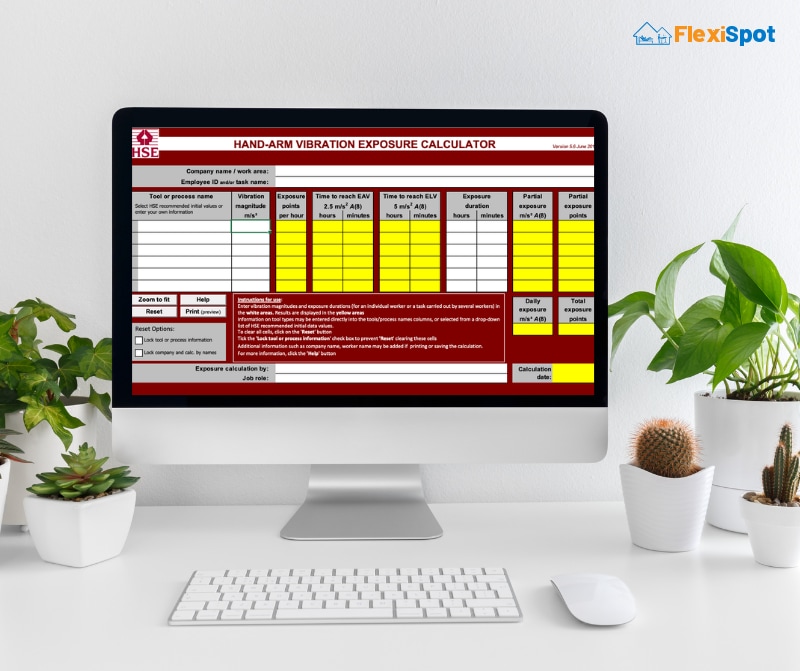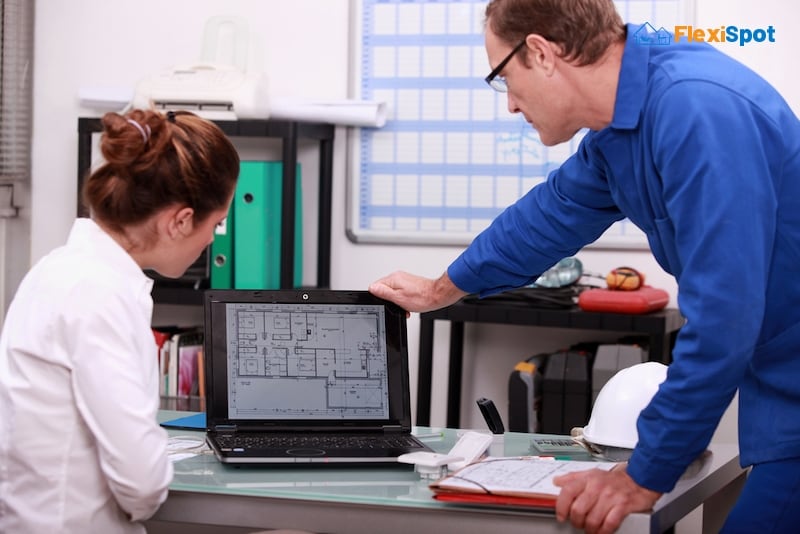Employees need to be safe and productive at work; thus, good ergonomic practices are essential. Managers at every workplace must understand the need to create a safe, healthy, and comfortable work environment for employee productivity and engagement.
How to perform Ergonomic Assessment of Workplace
Employees who operate at poorly built workstations or use appalling ergonomic work practices can contribute to an increase of various musculoskeletal illnesses that are avoidable. Workplace ergonomics can appear to be a difficult (and nearly impossible) profession for safety managers to master. After all, you already have a lot of hats to wear and only so much time throughout the day. With that in mind, we've compiled this resource list to help you get started without becoming overwhelmed.
So, what is ergonomics, exactly? What are the advantages? What's the best way to get started? How can you receive the resources and managerial support you need to build a successful process? The measures below, together with knowledge and planning, can ensure that your workplace ergonomic assessment is both successful and efficient. The questions keep coming, and we're here to help. Here are a few useful tips for improving workplace ergonomics:
Ergonomic assessments are performed in the workplace to assess the risk of developing musculoskeletal injuries. If a worker's computer workstation is not properly set up, it can lead to damage and pain. Or, even worse, it could lead to a Worker's Compensation claim. Ergonomic assessments might be one of the strategies that individuals and corporations can employ to alleviate this financial burden.
With the ever-changing constraints imposed by the COVID-19 epidemic, doing office work from home is becoming more common and accepted. Many employees may not have a dedicated office area set up in the same way as their workstation at the corporate office. New issues in terms of ergonomic hazard exposure and worker safety have arisen as a result of this. Despite the increased hurdles, the responsibilities remain the same. As a result, under Occupational Health and Safety Act clause 25(2)(h), it is the employer's responsibility to take all necessary precautions to safeguard the safety and health of their employees. In these circumstances, it is legally advantageous for the employer to do ergonomic hazard risk evaluations of their employees' workspaces when they work from home to protect their safety and health.
An ergonomic assessment's goals are to identify the workplace's physical and psychosocial risk factors, quantify the risk, and make the required improvements to the workstation or task to reduce the risk. When we think about workplace ergonomics, we first consider three factors. Lower back pain is the first thing that comes to mind, followed by long hours of sitting, and finally, office chairs. Lower back discomfort is caused in this scenario by exposure to ergonomic dangers, such as sitting in a static position for an extended amount of time and the type of office desk utilized. Even while these are risk factors, they can also be beneficial. Assessing present workstation furniture and tasks can assist reduce ergonomic hazard exposures, resulting in advantages for both the individual and the company.
The magnitude of exposure must be determined, assessed, and then controlled in order to safeguard workers from ergonomic hazards. The benefits of an ergonomic assessment can be realized at both the organizational and individual worker levels when performed by an objective and qualified expert. Companies throughout the world are touting their products, services, and workspaces as ergonomic, and office workers have a lot of concerns about it. You may have suspected that ergonomics is important in some way, but you may still be wondering what ergonomics actually means.
This article delves into the fundamentals of ergonomics, covering everything from the terminology to how an ergonomically sound office workstation can help you prevent weariness and discomfort.
6 Steps to Conducting a Workplace Ergonomic Assessment
Conducting an ergonomic assessment successfully is an easy process at its core: Examine the working environment, as well as how your employees interact with it. Of course, there's a lot more to it. However, as you begin your ergonomic assessment, keep these general aims in mind so that you may focus on the particulars without getting bogged down in unimportant minutiae. Here are five step-by-step instructions for doing a good ergonomic assessment:
1. Examine any previously collected data
The first stage in any ergonomics assessment is to gather information about your workplace and establish a baseline. Examine first aid logs, worker's compensation reports, workplace injury reports, claims data, safety committee meeting minutes, and any other useful information you have to learn about any work-related incidents or injuries that have occurred at your place of business. Identify any higher-risk activities or departments, as well as common injuries and complaints, when you evaluate this data.
This will enable you to focus your ergonomics evaluation and improvement efforts on the areas that will yield the best results. Taking a history is the first step in creating or improving your ergonomics program. You must first establish a baseline understanding of previous work-related incidents and injuries.
This can allow you to pinpoint high-risk departments or job kinds, as well as common concerns, injuries, and complaints. As a result, a data-driven standard will be established, which will be critical for gauging future success.
2. Select your Instruments
Ergonomic assessment tools act as the backbone of the ergonomic workplace assessment. You'll want to make sure you choose the correct ergonomic assessment instrument because it's one of the most important decisions you'll make when adopting an ergonomics process.
You'll gather and analyze current data on your workplace and workforce during the final three steps of your ergonomics assessment. It's crucial to take a step back and figure out how you'll measure this data before proceeding. You don't have to come up with these ergonomics measurements on your own, thankfully. The National Institute of Occupational Safety and Health, for example, has produced well-respected ergonomics evaluation methods that are freely available in the public domain. Here are some of the greatest ergonomics assessment tools on the market:
Checklist for WISHA Caution Zones
Checklist for Hazardous Areas (WISHA)
The NIOSH Lifting Equation
Rapid Assessment of the Entire Body (REBA)
Rapid Upper Limb Evaluation (RULA)
Vibration Calculator for Hands and Arms (HAV)
The majority of these tools are available online, and several have also produced mobile versions. Choose the techniques that pertain to your facilities or workplace and use these as the grounds for assembling your objective data.
To track progress and identify areas for improvement, your company will most likely undertake initial and follow-up ergonomic assessments. As a result, establishing a uniform assessment technique and set of tools is critical so that you can compare apples to apples and precisely identify risk indicators.
Create an ergonomic assessment that includes your approach, as well as the tools you'll need to collect objective and subjective data. Then, using the brief as a reference, ensure that each assessment uses the same tools and documentation procedures.
3. Collect subjective information
We propose starting with a hands-on, subjective examination of your current workplace rather than jumping right in with your chosen instruments and assessing ergonomic risk factors. Begin by taking a tour around the floor or offices to obtain a sense of the environment in which your workers operate and taking notes on any issue areas you notice.
Remember to be critical and approach your employment with fresh eyes, as if you were an outsider. Pull employees aside during your walk-through for a quick discussion regarding their working circumstances. You may boost the likelihood of early buy-in and support for any future adjustments by incorporating your staff in the process.
This stage will also provide you with vital first-hand stories and insights that you may not otherwise be able to obtain. Make sure you thoroughly describe your goals and promote open, honest feedback. Larger workplaces may choose to undertake an employee comfort survey in addition to face-to-face interactions with individual employees to collect more direct input.
4. Collect Objective Data
Use all of the information you've gathered to create a prioritized list of work activities and departments that need to be evaluated after you've studied your work injury history, walked your workplace, and gotten direct input. To measure your risk variables and complete your objective evaluation, use the ergonomics assessment tools you've chosen.
It's time to move on to the more objective part of the assessment process once you've evaluated hard incident and injury data and observed and engaged people in their work environment.
5. Take a look at your facilities
If you want your ergonomics program to be a success, you'll need first-hand understanding of the surroundings in which employees operate. Consider taking a walk around the facility. By traveling on-site to collect subjective observations, you can get a peek of workers in action. To assist you remember specific facts and produce improved suggestions, take thorough notes and consider collecting images and video.
6. Examine all data and assign a risk rating
Finally, compile all of the data and insights into a list of risk-reduction options and risk factors. Analyze all of your current data, as well as the new objective and subjective data you collected throughout the evaluation, in its entirety, as well as by task and department. Identify significant insights and risk-mitigation options, and rank them according to the likelihood of injury and severity of the injury. We also advocate determining short- and long-term effect regions. You'll receive a detailed, actionable assessment of all ergonomic risk factors once you've finished these five steps. You're ready to devise a plan to mitigate these dangers and improve workplace ergonomics.
Final Thoughts
Conducting ergonomic risk assessments in a systematic manner provides you with a clear picture of the risk that exists in your workplace. This clear picture can help you discuss priorities and implement workplace improvements more effectively. Since ergonomic evaluations are the foundation of the ergonomics improvement process, being effective and efficient while observing and analyzing your workplace is critical.







